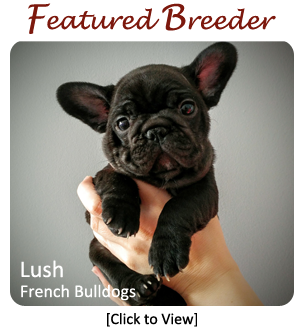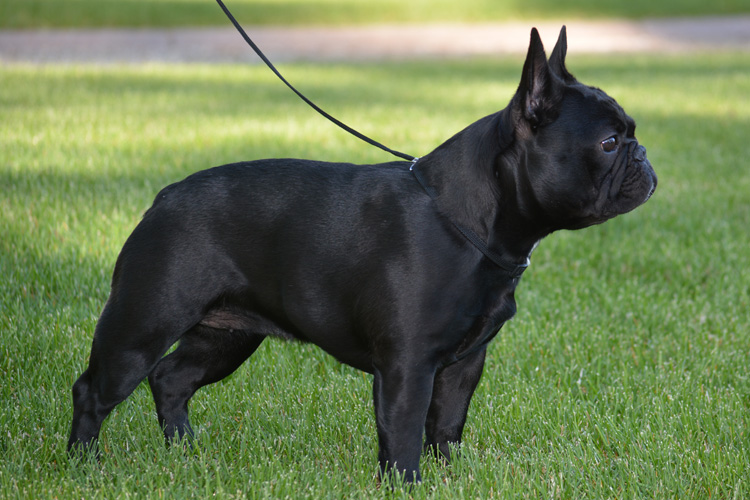
French Bulldog
Group: Non-Sporting
Origin: France
Height/Weight:
- – Lightweight: under 10 kg
– Heavyweight: 10 kg and up to but not over 13 kg
AKA: Frenchie, Bulldogue Français
CLICK HERE to View Breeder Listings
Breed Profile
The French Bulldog is a playful and alert small breed who is happiest when surrounded by family. The Frenchie is said to be a quiet and well-mannered dog that does not bark unnecessarily. Bred primarily as a companion dog, the French Bulldog does have a protective nature which makes him a good watch dog as well. As with other short-nosed breeds, the Frenchie may snort and snore when sleeping.
Frenchies are an excellent choice for the less active owner as his exercise requirements are moderate. They do enjoy daily walks and outdoor activities but because of their short noses, they should not be exercised on hot, humid days.
His coat is short, fine and smooth. Ranging in colours from brindle, fawn, cream, white, brindle and white, brindle pied, and black-masked fawn. Two distinctive features of the Frenchie are his bat shaped ears and the flatness of his skull between his ears.
A Bit of Breed History
The foundation for the French Bulldog breed came from the old Bulldog of 150 to 200 years ago in England. Around this time, a group of breeders developed a smaller, lighter Bulldog of 12-25 lbs in weight. This dog had either upright or rose ears, rounded foreheads and short underjaws. It is said that they also had a bit of a terrier temperament. These dogs became quite popular in the English midlands and soon were taken to the North of France where many people emigrated during the industrial revolution. Once in France, their popularity spread from Normandy to Paris and soon they became known as the Bouledogues Francais. Over time, a more uniform breed was developed: a dog with a compact body, straight legs, and without the extreme underjaw of the English Bulldog. Their ears were either erect “bat ears” or “rose” ears.
Americans travelling to France fell in love with the little dogs and began bringing them back to the United States. Popularity of the breed skyrocketed until after World War I when the numbers began a decline that would last 50 years. By 1940, the French Bulldog was considered a rare breed and only 100 were registered with the American Kennel Club. The 1980s started to show signs of a resurgence in popularity with numbers increasing to 632 registrations by 1990. Since then, the popularity of the French Bulldog has soared and by 2006, there were more than 5,000 registered with the AKC alone.
Sire: INT.CH. Store Linde’s Kleos Le Regal
Dam: Can. GR. CH. Vanesa Draczyn
Owner: Renata Dabrowski – Paris Moon Kennel
www.parismoonkennel.ca
Health Issues
Like all breeds of dogs, the French Bulldog does have some health concerns, among them is Brachycephalic Syndrome or Brachycephalic Airway Obstruction Syndrome (BAOS). The problems associated with this disorder can range from simple snorting to collapsing episodes. Over time, increased strain may be placed on the heart as well. Overheating is dangerous to dogs with this syndrome as excessive panting can cause further swelling and narrowing of the airways. For further information on this, please see What is brachycephalic syndrome?
If you are considering the adoption of a French Bulldog puppy, or any breed, it is very important to be selective in choosing a responsible and reputable breeder. Ensure that the prospective puppy’s parents have all health clearances. Breeding of any dog should not be done until after they have been proven to be free of evidence of significant hereditary diseases. (For more information on selecting a breeder, see the articles on the General Information page.)
Additional Health Resources:
- Health and Nutrition — Growing section of the Canada’s Guide to Dogs website which includes information on several health and nutrition related issues.
- Canine Health Information Center (CHIC) — Providing a source of health information for owners, breeders, and scientists that will assist in breeding healthy dogs. CHIC is a centralized canine health database jointly sponsored by the AKC/Canine Health Foundation (AKC/CHF) and the Orthopedic Foundation for Animals (OFA).
- AKC Canine Health Foundation — Working towards developing scientific advances in canine health.
- OFA – Companion Animal Eye Registry (CAER)
- Orthopedic Foundation for Animals (OFA)
- Ontario Veterinary College (OVC)
- University of Pennsylvania Hip Improvement Program (PennHip)
- HealthGene — HealthGene Corporation is the leading provider of veterinary DNA diagnostic services in Canada.
- Labgenvet — Laboratory of Veterinary Genetics is a Canadian diagnostic laboratory that offers a comprehensive service of DNA tests for veterinary genetic diseases.
Grooming Information
- Grooming — This section of the Canada’s Guide to Dogs website includes tips, articles and information covering all aspects of dog grooming along with a listing of Groomers from across Canada.
Did You Know?
- In 2015, the French Bulldog made it into the Canadian Kennel Club’s top 10 list of most registered breeds for the first time.
- The French Bulldog Club of America (FBDCA) was founded in 1897 and is the oldest club in the world dedicated to the French Bulldog breed.
- The French Bulldog was first exhibited at Westminster in 1896 and a Frenchie was featured on the cover of the 1897 Westminster catalog even though it was not yet an approved AKC breed.
- Originally the French Bulldog had both “bat” (upright, rounded ears) and “rose” ears (folded over ears). American fanciers of the breed preferred the “bat” ears and this has carried over into the breed standard.
Training Resources
- Training — For training information, see this growing section of the Canada’s Guide to Dogs website for tips, articles, as well as listings of training centres across Canada.
A Few More Interesting Facts
Frenchies and Celebrities — Just to name a few: Lady Gaga, Zach Braff, Hilary Duff, Leonardo DiCaprio and Hugh Jackman are all proud owners of Frenchies — making them celebrities in their own right from being published in the tabloids.
Movie Star French Bulldogs — Frenchies have been featured in many movies and television shows, including: From Hell starring Johnny Depp; Secondhand Lions with Michael Caine and Robert Duval; and Bringing Down the House with Steve Martin. A French Bulldog can also be seen in the movie “Titanic” portraying a Frenchie that actually did travel on the ship.
Singing French Bulldogs — Although French Bulldogs are known to be quiet dogs, barking only when there is a reason to do so, they do like to vocalize via yawning, yipping, snorting, snuffling, gargling and even singing along.
Additional Information
- Clubs, Sports & Activities — For information on the many sports and activities you can get involved in with your dog.
- Working Dogs — The Working Dogs section of the Canada’s Guide to Dogs website provides information and listings of organizations that are involved in various dog jobs, such as Guide Dogs, Therapy Dogs, Police Dogs, Protection Dogs, and much more.
*NOTE 1: CHIC – The Canine Health Information Center “is a database of consolidated health screening results from multiple sources. Co-sponsored by the Orthopedic Foundation for Animals (OFA) and the American Kennel Club (AKC) Canine Health Foundation, CHIC works with parent clubs to identify health screening protocols appropriate for individual breeds. Dogs tested in accordance with the parent club established requirements, that have their results registered and made available in the public domain are issued CHIC numbers.” To learn more, visit: www.caninehealthinfo.org
*NOTE 2: The Fédération Cynologique International (FCI) is the World Canine Organization, which includes 91 members and contract partners (one member per country) that each issue their own pedigrees and train their own judges. The FCI recognizes 344 breeds, with each being the “property” of a specific country. The “owner” countries write the standards of these breeds in co-operation with the Standards and Scientific Commissions of the FCI, and the translation and updating are carried out by the FCI. The FCI is not a breed registry nor does it issue pedigrees.
Breed Listing
Quick Links
Get In Touch
- Email: canadasguidetodogs@gmail.com
- Email: info@canadasguidetodogs.com
- Visit us on Facebook: www.facebook.com/CanadasGuideToDogs
— CanadasGuideToDogs.com is an Amazon Associate as well as a participant in various affiliate programs, as such fees are earned from qualifying purchases.





